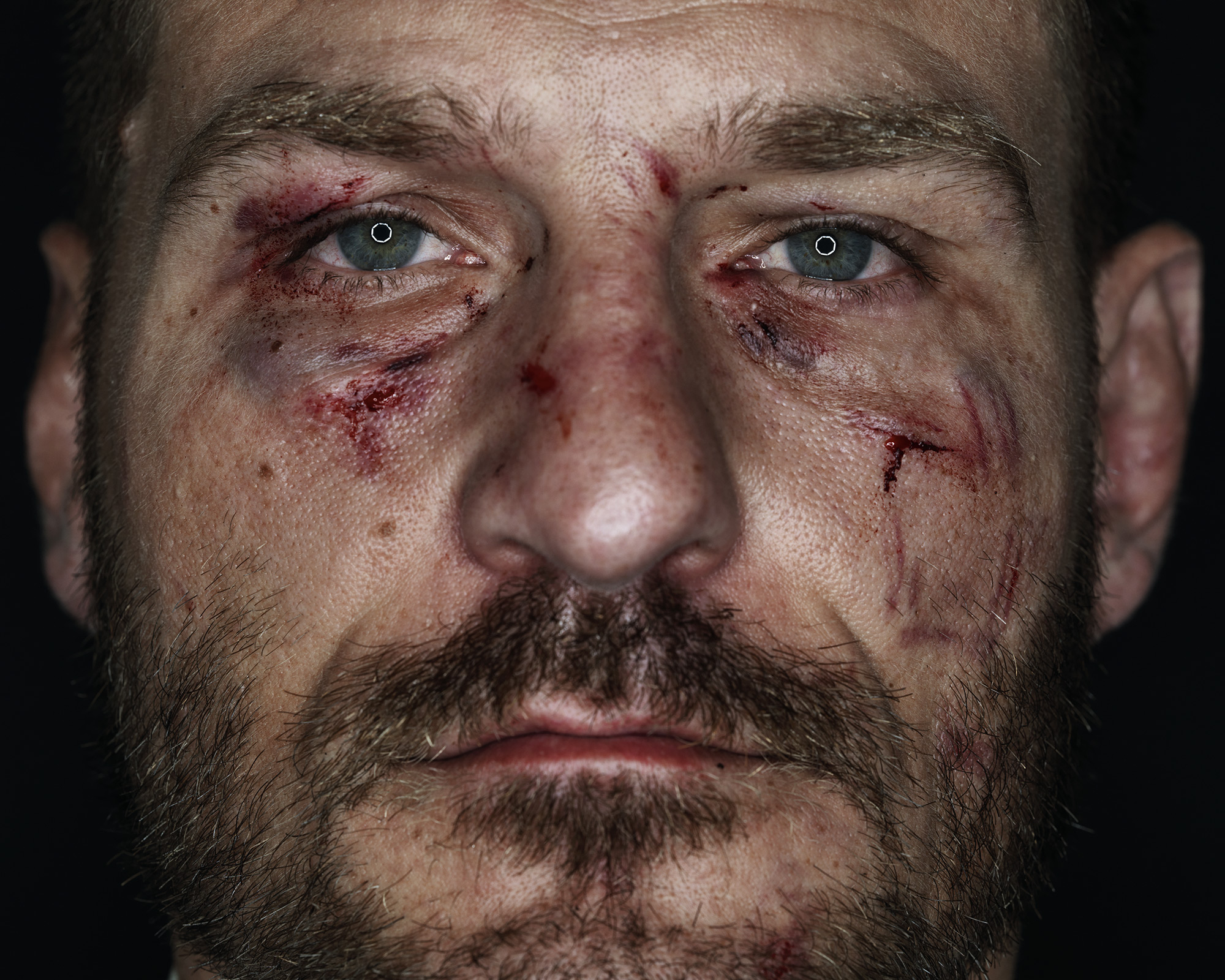Last Updated on 11/11/2021 by Chris Gampat
Ever wanted to know what life is like inside the competitive world of mixed martial arts? Kevin Lynch is about to show you…
Brutal. Violent. Archaic. These were just a few of the adjectives used to describe the world of mixed martial arts (MMA). At the time of its inception, the bloody battles of the UFC were widely frowned upon. Many wanted it banned. However, 26 years later, it is now one of the biggest and most respected organizations in all sports. In 2002, photographer Kevin Lynch became involved with the UFC. Documenting both the action and the fighters, he would go on to create one of the most influential books in combat sports, Octagon.
“…it didn’t take long before this UFC virus infected me as well,” he says as he speaks of how the sport got him hooked. During his first 10 years with the company, he got to know much more than the fighters. He connected with the humans living behind the aggressive, intimidating barrier so commonly associated with the mixed martial arts. Kevin was with them before the fight – camera in hand – and after the fight, for what would become a sub-series titled, Before and After.
Kevin kindly took the time to share more with us abut what life was like as a photographer in a world that was once greatly unaccepted.
Note: Some images in this piece show acts of violence and blood, which some readers may find disturbing.
Phoblographer: When you first worked with the UFC, it was at a time when, due to its graphic violence, it wasn’t widely accepted. Personally, what were your first impressions of MMA when you started shooting it?
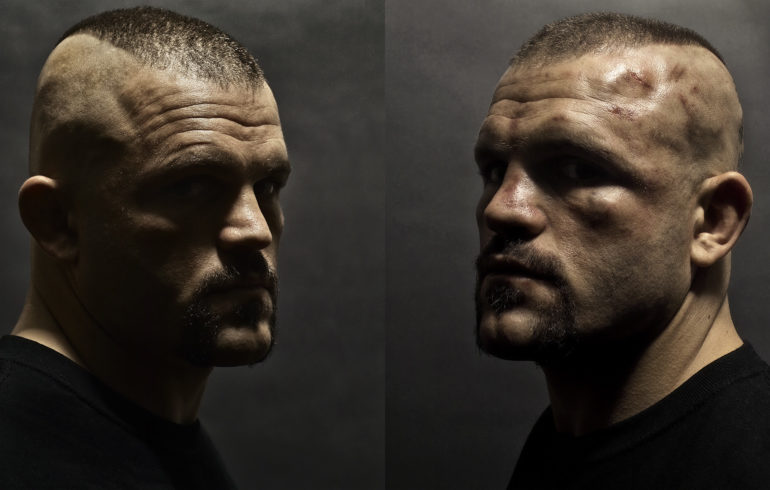
KL: My first encounter with the world of MMA and the Ultimate Fighting Championship was in 2002. I was contracted by the UFC to create images of Tito Ortiz and Ken Shamrock for their upcoming UFC40 event. The new ownership was looking for innovative publicity and marketing ideas to enhance the public perception of their product and broaden their audience. They hired a New York-based AD Agency that had a marketing background in creating publicity and advertising concepts for WWE promotion. (Wrestlers expressing angry threatening faces and fingers into the camera, theatrics, etc.)
The UFC40 billboard concept layouts had mirrored a similar approach. After witnessing my first UFC fight up-close on the Octagon I realized that this approach was falsely misrepresenting the fighters, therefore, the integrity of the sport, and it could potentially alienate their fans and scare off new audiences. While I was standing on the Octagon to take pictures of the event I was perplexed by the sell-out crowd’s adrenalin rush, however, the whole concept quickly grew on me.
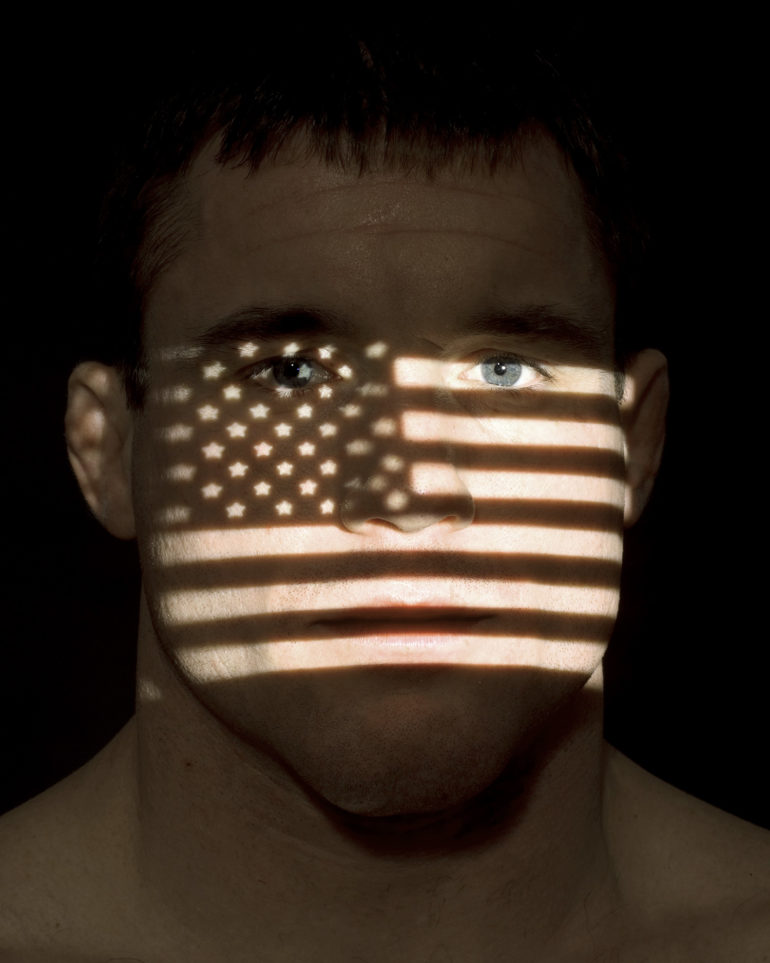
“My goal was to honestly portray the beauty without glorifying violence.”
An Ultimate Fighter could be characterized as a person who has the ability to suppress logic and reason and allow the will to surface. These fighters are part of a brotherhood; the dojo is their church, indoctrinating the beliefs of honor, bravery, courage, and loyalty. The UFC fan idolizes and lives vicariously through them. I saw the potential of a great book project, a subject matter offering so many layers and interesting perspectives; quite the juicy stuff for a photographer to capitalize on. I originally presented to Dana White five concepts for the Octagon Book Project:
Concept One: Before & After
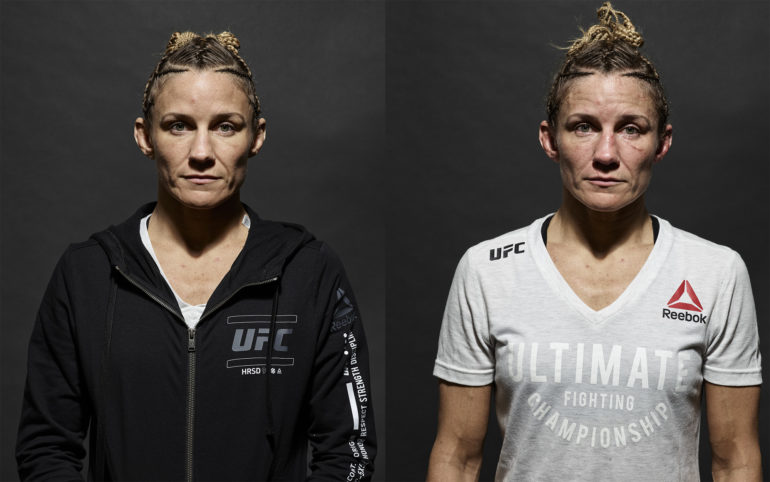
“Before & After” images of the fighters at the event. Right before they go out and right after they return to their locker rooms. The three to five rounds, fifteen to twenty-five minutes transform a fighter emotionally, physically, economically, and spiritually. I also created an Octagon shaped light converted from a Profoto Ring-lite to emulate an Octagon shape into the fighter’s eyes for extreme close-ups.
Concept Two: Octagon locker room action
The idea was to have unfettered access at the event, which included having all-access to the Octagon and locker rooms, etc. This approach documents the event upfront and close, behind the scenes documenting fights and training.
Concept Three: Introspectives
These images were shot most likely a day or two before the event and the concept was to demonstrate and express a fighter’s journey and inner feeling of what it feels like:
To have the anguish of losing, the celebration of winning, the humor of it all, types of meditation, prayer and preparation, the mood and hardships of finally getting there etc. The lighting was an overhead globe light on a dark grey seamless capturing these moods dramatically and intimately during the process.
Concept Four: MMA Movement
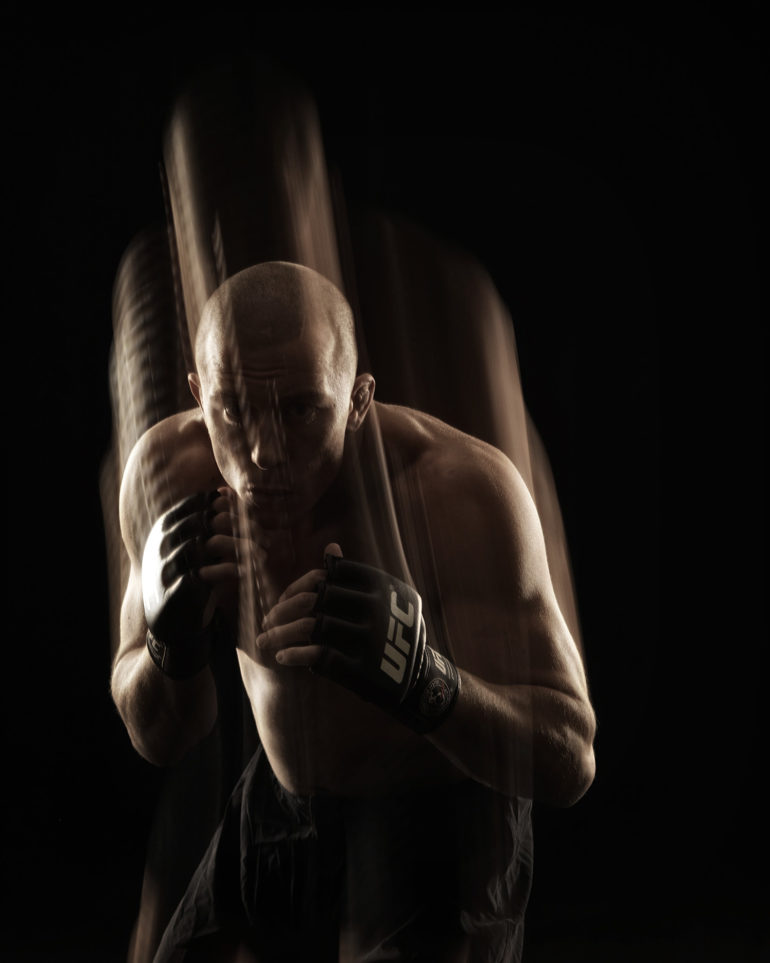
This is a reflection on the back of the “Mixed Martial Arts” in motion. These images were shot combined with an Arri 1250 HMI Par Fresnel and Medium Profoto Strip light strobes to create motion blur. Capturing the artistry and intensity of MMA Fighters movements. It allows for strong, interesting visual effects to appear when a fighter follows through with a kick or Superman punch etc.
Concept Five: Still life Concepts
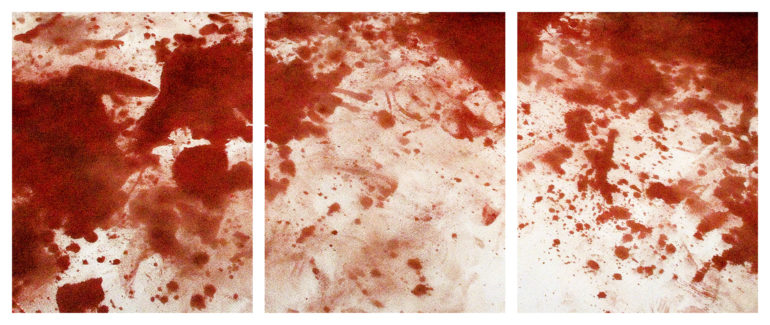
This objective was to develop abstract imagery with an unorthodox approach. Sometimes something that’s more abstract can actually portray a subject matter more realistically and vividly. By all means, I didn’t want to hide nor sugarcoat the brutality of the sport. I purposely brought it out in the open, so the conversation doesn’t end there but goes from there into the other aspects of MMA. My goal was to honestly portray the beauty without glorifying violence. Examples: Blood Triptych (abstract portrait of the bloody Octagon after 8 fights), 100 Wraps (collected one hundred used & signed wraps of fighters after their fights and formed them into an Octagon shaped still life), 100 Octagon (100 images shot of the building of the Octagon in an arena from 5:00am-5:00pm, shot every 8 minutes before the starting of the event and formed into an Octagon shaped 100 imagery contact sheet), Three perspectives of Knock Out: Blurry vision (fighter when he wakes up, by knockout, and an overhead), Inside-Outside the Octagon, Blood on Ice (fighters emerge their faces into a custom Plexiglas box and let the blood mix with the ice, etc.)
Phoblographer: Successful portraiture is built on trust and respect; a lot like MMA. How did you earn the trust and respect of the fighters and how long did it take to get to that point?
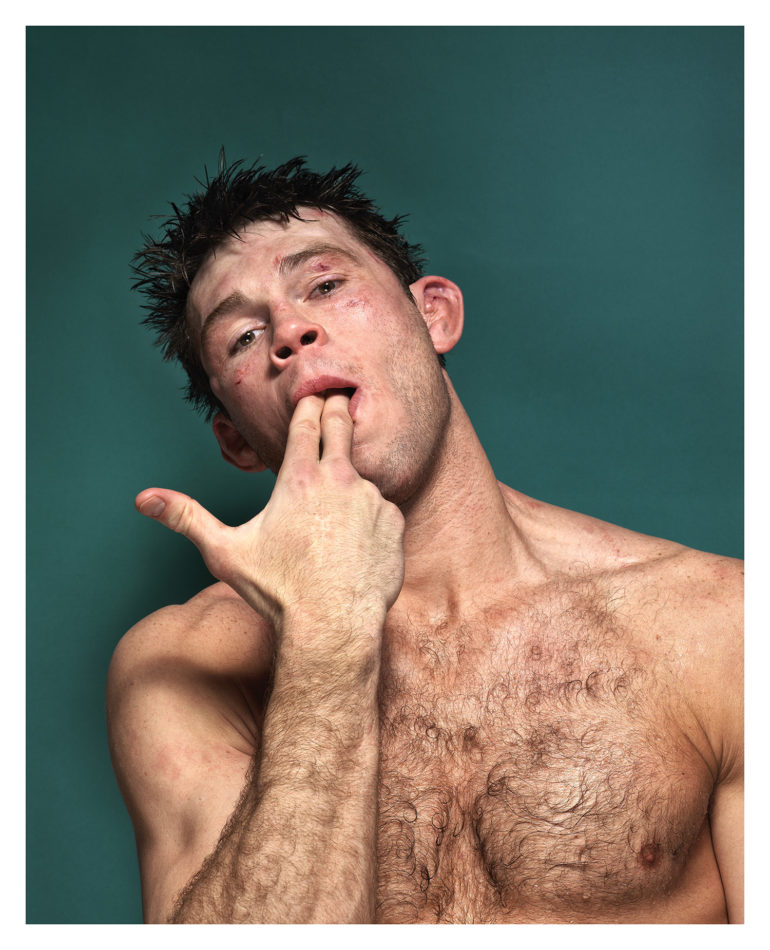
KL: There are no shortcuts in gaining trust. I would have to spend as much time as possible with the fighters and trainers, days and sometimes weeks prior to the event. This was critical in order to ensure the one opportunity of stopping them for a portrait right before or after their fights. Over time I would share Before and After imagery with of some of the other new fighters during the event, which I had taped up behind me so they could see I wasn’t just an ambulance chaser but genuinely trying to portray their “badges of honor” with dignity and respect. Also seeing mutual fighters dedication helped and encouraged them to want to do it. Deeper into the project most fighters became eager to participate and started to realize the historical value it may have.
“…it was the most invigorating project I’ve ever worked on.”
Phoblographer: Your book “Octagon” shows fighters before and after a fight. How was the pitch first received when the idea of taking a portrait of a man who had just incurred physical damage was put forward?
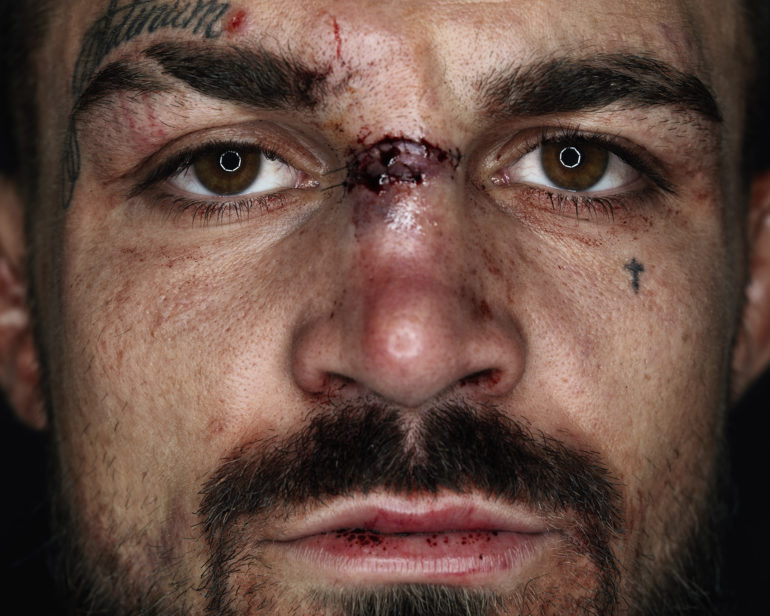
KL: It depends on their emotional state of mind in that moment and obviously their physical condition. Their trainer/fight camp may not want me to do it either. The point is I did my homework by spending an ample amount of time prior to the fights so they knew this was coming and needed to keep their word like I did mine. Dana White and Lorenzo Fertitta were also my biggest backers so I had the top brass giving me their blessing to be there. I rarely used that trump card though. Over time you really feel for these guys and hate to make them suffer more than needed. But I had an obligation and was fully committed to my project. Due to the changes made by the Nevada Commission, it is almost impossible today to get the fighters immediately after a fight. They are now sent right into the Doctors office for inspection and usually get cleaned and stitched up before anyone else has access to them. I had a window in time to do this and was so lucky to have had it.
Phoblographer: What were the biggest hurdles when photographing professional fighters?

KL: Once you “break bread” with the fighters they aren’t really difficult, in fact they’re usually quite friendly and open to having their picture taken, even though they are trying to stay focused on their objective. I had high expectations and was passionately committed to my five-year project (UFC didn’t have so many fights then, maybe five to six per year, so I needed to accumulate material.) Having total autonomy creatively and unlimited accessibility can create resentment and jealousy within the UFC company. At times I had developed new maneuvering skills so I could continue without compromising the creative process. All said, it was the most invigorating project I’ve ever worked on.
Phoblographer: When you returned, you were able to shoot female fighters. Did you notice any difference in terms of how they behaved in front of the camera in comparison to the men?
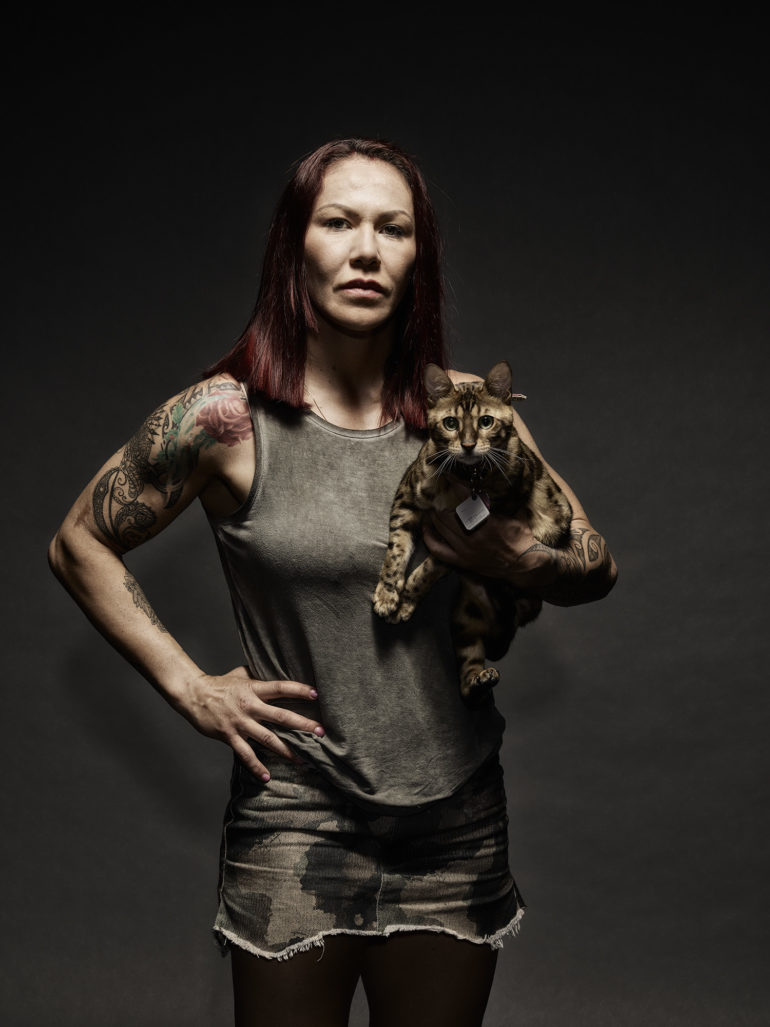
KL: I was impressed with all of the professional female fighters I photographed and approached them the same as I did the men. I try to gain their trust so I can reveal, in the short time I have, who they are inside. It’s a collaboration.
“I cherished my moments with B.J Penn, Matt Hughes, GSP, Randy Couture, Chuck Liddell etc.”
Phoblographer: Out of all the fighters you shot, which one most broke the stereotype of “tough, cold personality” and was actually quite sensitive and thoughtful?
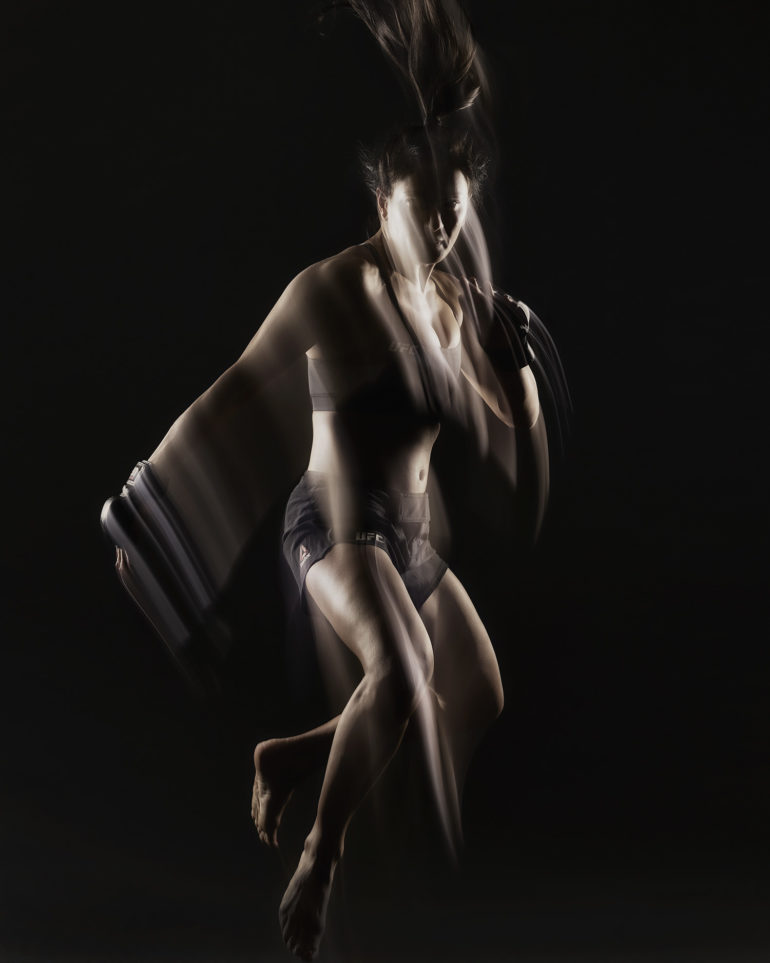
KL: At first when she walks in Cris Cyborg impresses anyone with her amazing appearance and athleticism. She’s so powerful and confident, but she’s also open-minded as she was into experimenting creatively during the shoot. She also maintained all the wonderful attributes women have for me. She brought her cat and we did a sweet portrait of the two of them showing a loving-soft side to her you might not expect at first. I was intrigued by her lovely disposition; she’s someone you would want to be friends with. Karolina Kowalkiewicz was crazy fast in front of the camera while kicking and jumping into my lens. She is also quite beautiful and could fool you into thinking she’s a model but she has the physical secret weapons of a James Bond character that could wipe you out in a blink of an eye – and trust me she can and will if she chooses to do so.
Phoblographer: If you can share, did you have any favorite fighters, ones that you would back to win?
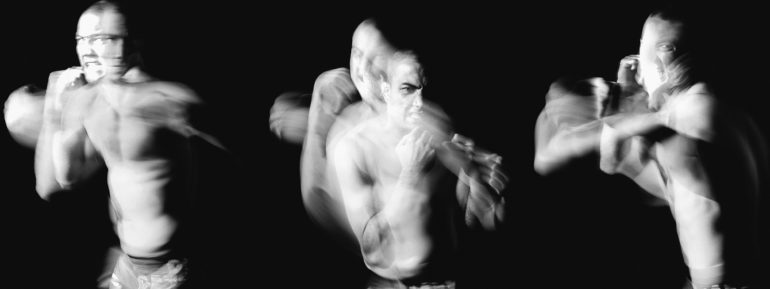
KL: It’s hard to stay objective when you are doing a project over so many years but I was most impressed with these fighters and it’s more their personality than their talent that I’m intrigued by. They were really special people but then again aren’t all UFC fighters…I cherished my moments with B.J Penn, Matt Hughes, GSP, Randy Couture, Chuck Liddell.
Phoblographer: How do you feel about your involvement with the sport of MMA/UFC and photography’s contribution to making it what is today – a highly popular, successful multi-billion dollar organization?

KL: My project’s objective was to build a bridge between the blue and white-collar worlds and I believe that the Octagon project successfully contributed to that. The visionaries are not we the photographers but the people like Frank, Lorenzo, and Dana who gave me the freedom to do so.
It was a privilege and great honor to be part of it and I hope that my photography reflects that immense respect I have for these incredible athletes and unique human beings.

You can see more of Kevin’s work by visiting his website.
All images by Kevin Lynch. Used with permission. Lead photograph is a portrait of Stipe Miocic


